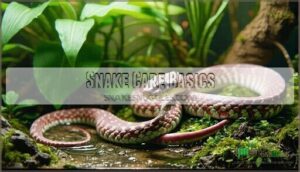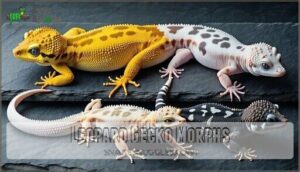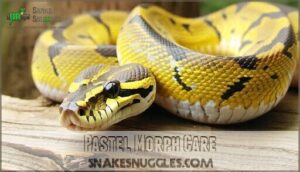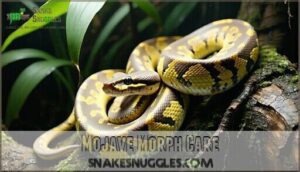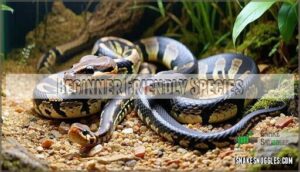This site is supported by our readers. We may earn a commission, at no cost to you, if you purchase through links.
 Beginner snake morph care starts with choosing the right species and understanding what makes each morph unique.
Beginner snake morph care starts with choosing the right species and understanding what makes each morph unique.
You’ll want to focus on hardy species like ball pythons or corn snakes—they’re forgiving and come in stunning color variations.
Set up proper heating, humidity, and hiding spots before bringing your new friend home.
Don’t get caught up in expensive morphs right away; normal morphs are just as rewarding and often healthier.
The key is nailing the basics: consistent temperatures, appropriate prey size, and gentle handling techniques.
Once you’ve mastered these fundamentals, the colorful world of morphs becomes much more manageable and exciting.
Table Of Contents
- Key Takeaways
- Choosing Right Morph
- Snake Care Basics
- Popular Beginner Morphs
- Morph Specific Care
- Health and Hygiene
- Handling and Taming
- Beginner Friendly Species
- Advanced Care Topics
- Frequently Asked Questions (FAQs)
- Which snake is best for beginners?
- How to choose a pet snake for beginners?
- Is woma python a good beginner snake?
- How often should you feed a mouse to a snake?
- How do you quarantine a snake?
- Do slithery snakes need a vet check-up?
- What is the easiest snake to take care of for beginners?
- How do you take care of a snake for beginners?
- What to do when you first get a corn snake?
- How to care for newly hatched snakes?
- Conclusion
Key Takeaways
- Start with hardy species like corn snakes or ball pythons—they’re forgiving and won’t punish your learning mistakes with health crises.
- Master the basics first by maintaining consistent temperatures (88-92°F basking, 75-80°F cool), proper humidity (50-60%), and gentle handling techniques before chasing expensive morphs.
- Choose reputable breeders who offer health guarantees and transparent care practices rather than grabbing the cheapest option online.
- Focus on normal morphs initially—they’re healthier, more affordable ($20-150), and teach you essential skills without the complications that designer genetics can bring.
Choosing Right Morph
You’ll want to choose your first snake morph carefully since it’ll be your introduction to reptile keeping.
The right morph combines good temperament, reliable feeding habits, and manageable care requirements that won’t overwhelm a beginner, with reliable feeding habits being crucial for a smooth experience.
Researching Reputable Breeders
Finding quality reputable breeders requires homework, but it’s worth the effort.
Start with MorphMarket’s breeder listings—they’ve got ratings and buyer feedback that’ll save you headaches.
Look for breeders offering health guarantees and transparent answers about their snake morph care practices.
Many breeders also offer amphibians and invertebrates on their sales platforms.
High-quality breeders showcase genetic expertise through detailed documentation provided with each beginner-friendly morph, proving their commitment to breeder ethics.
Understanding Morph Prices
After finding a trustworthy breeder, you’ll face the reality check of snake morph pricing. Understanding market price trends helps you budget smartly and avoid overpaying for your first pet.
Here’s what drives beginner snake morph costs:
- Morph rarity – Common morphs like ball python normals cost $20-50, while rare designer combinations reach $1,300+
- Genetic lineage – Single-gene morphs stay affordable at $100-400, complex genetics spike prices dramatically
- Breeder reputation – Established breeders charge premium but offer health guarantees and proper documentation
- Market trends – New morphs drop 80% in price as availability increases over 2-3 years
- Investment potential – Breeding-quality females cost more than pet-only males within same morph
Most beginner-friendly morphs fall into the $65-150 sweet spot, making them accessible while you master basic husbandry skills. Remember that essential supplies matter and can add to the initial investment.
Considering Temperament
Beyond price considerations, your chosen beginner snake morph’s temperament directly impacts your experience as a new keeper.
Some docile morphs like pastels handle stress better, while others show individual variation in bite risk and stress signs.
| Morph Type | Temperament Traits | Handling Frequency |
|---|---|---|
| Pastel Ball Python | Calm, predictable responses | 2-3 times weekly |
| Albino Corn Snake | Gentle, rarely defensive | Daily (short sessions) |
| Mojave Ball Python | Docile temperament, easy-going | 2-3 times weekly |
| Butter Ball Python | Exceptionally calm nature | 3-4 times weekly |
| Normal Corn Snake | Active but manageable | Daily handling tolerated |
Location and Laws to Consider
Before bringing home your dream snake, you’ll need to navigate the legal maze of snake ownership.
Nineteen states ban exotic reptiles entirely, while others require permits. Local ordinances can override state regulations – cities like New York prohibit pythons completely.
Research state regulations, exotic permits, and breeder licensing requirements. Check for invasive species restrictions that affect regional laws and snake legality in your area.
Some regions may also have specific rules regarding the milk snake’s legality, so be sure to check.
Snake Care Basics
You’ll need the right setup to keep your snake healthy and thriving, whether you choose a pastel ball python or colorful corn snake.
Getting the basics right from day one prevents most common problems and creates a stress-free environment for both you and your new pet, which is crucial for keeping your snake healthy.
Tank Size and Setup
When setting up your appropriately sized tank, remember that your snake’s home becomes their entire world.
Start with a 20-gallon enclosure for juveniles, upgrading to 40+ gallons for adults in beginner snake ownership.
Essential snake enclosure setup priorities:
- Enclosure Security – Secure, escape-proof lids prevent midnight adventures
- Substrate Options – Aspen shavings or reptile carpet for easy cleaning
- Hiding Places – Two hides (warm and cool sides) reduce stress
Your reptile tank setup needs proper Ventilation Needs through mesh tops, while Lighting Requirements stay minimal since most snakes prefer dimmer environments.
To guarantee proper shedding, consider how to maintain adequate humidity.
Temperature and Humidity Control
How do you keep your snake comfortable and healthy? Creating the right thermal gradient setup is essential for snake morph temperature control.
Set your basking spot temp at 88-92°F and cool side at 75-85°F. Maintain snake morph humidity between 50-60% with proper enclosure ventilation.
Many keepers utilize a quality heat source for ideal temperatures. Monitor humidity levels closely to prevent shedding issues, especially during their natural cycle when reptile humidity needs increase, and ensure a proper enclosure ventilation.
Feeding and Handling Techniques
Your snake’s diet revolves around frozen-thawed prey matched to its girth.
Feed juveniles weekly, adults every 10-14 days. During fasting periods, don’t panic—it’s normal behavior.
Handle gently for 5-10 minutes, avoiding post-feeding sessions and shedding periods.
Snake morph feeding habits vary, but most accept rodents readily. Proper handling safety prevents stress and builds trust, which is essential for a healthy and thriving snake, and it involves gentle care.
Popular Beginner Morphs
You’ll find three main species dominate the beginner-friendly morph scene: ball pythons, corn snakes, and leopard geckos.
Each offers stunning color variations that won’t break your budget or test your patience as a new keeper, with beginner-friendly options available.
Ball Python Morphs
Ball python morphs offer endless possibilities for beginners exploring morph genetics and pattern variations.
Popular beginner-friendly morphs like Pastel brighten color intensity naturally, while Albino creates stunning white-and-yellow combinations.
Designer morphs such as Banana and Butter provide gentle temperaments perfect for new owners.
These ball python morph options typically avoid serious morph health issues, making reptile care manageable for first-time snake enthusiasts.
Many owners enjoy browsing available ball python morphs to find the perfect snake.
Corn Snake Morphs
Why choose corn snake morphs when you’re starting your reptile journey? These docile snakes offer stunning pattern variations and color genetics that’ll make you fall in love instantly.
Corn snakes represent some of the most beginner-friendly morphs available, with easy snake morphs perfect for new keepers.
- Vibrant orange and red bands that shimmer like autumn leaves
- Snow morphs displaying pristine white scales with pink undertones
- Amelanistic varieties showcasing brilliant yellows without dark pigments
- Okeetee morphs featuring bold black borders around orange saddles
- Candy cane patterns with clean red and white striping
Morph identification becomes second nature as you observe these future morphs developing. Many resources discuss available corn snake morphs to help with understanding snake morphs fundamentals. Rare morphs exist, but common varieties provide excellent learning opportunities.
Leopard Gecko Morphs
While corn snakes offer vibrant patterns, leopard geckos showcase equally stunning genetic variations through their morph aesthetics.
These reptile genetic variations create unique mutations that make breeding projects exciting for beginners exploring reptile morphology.
| Morph Type | Price Range |
|---|---|
| High Yellow | $25-$40 |
| Albino Variants | $100-$200 |
| Patternless/Blizzard | $100-$400 |
| Rare (Black Night) | $1,000-$3,500 |
Morph identification becomes straightforward once you understand genetic traits. Future morphs continue emerging as breeders develop new combinations, making leopard geckos perfect starter reptiles for those interested in genetics.
Morph Specific Care
Each morph has its own quirks that’ll make your snake-keeping journey smoother once you know the tricks.
You’ll find that pastel, albino, and mojave morphs each need slightly different approaches to thrive in your care.
Pastel Morph Care
Pastel genetics create stunning visual appeal through co-dominant traits that brighten your snake’s natural colors.
These beginner-friendly morphs showcase vibrant yellow tones with distinctive blushing patterns, making color variations pop beautifully.
You’ll love how brightness levels intensify compared to normal ball pythons, while pattern intensity remains manageable for new owners.
Their excellent breeding potential means future project possibilities, though many keepers simply enjoy their snake’s striking appearance and calm snake temperament perfect for learning essential snake care tips.
Albino Morph Care
Albino morphs bring stunning red eyes and bright white-yellow coloration, but their beauty comes with special needs.
Albino morphs captivate with their ethereal beauty, but their light-sensitive nature demands thoughtful care from dedicated keepers.
These beginner-friendly morphs need careful albino lighting management since sun sensitivity can harm their delicate skin. Skip harsh UVB bulbs and opt for gentle ambient lighting instead.
Their red eyes make them more photosensitive than other snake temperament types. You’ll find breeding albino snakes rewarding, though vitamin needs remain standard with proper whole-prey diets.
These snake care tips guarantee your albino morph thrives beautifully, with proper care and whole-prey diets.
Mojave Morph Care
Beyond their striking pattern variations, Mojave ball python morphs offer exceptional breeding potential and beginner-friendly temperament traits that make snake morph care requirements surprisingly manageable.
- Mojave genetics create high-contrast patterns perfect for future breeding projects
- Temperature gradient of 75-80°F cool side, 84-89°F warm side works perfectly
- Enclosure enrichment with branches and hides reduces stress substantially
- Feeding schedule every 5-7 days for juveniles keeps growth steady
- Humidity levels at 50-60% (75% during shedding) prevents skin issues
Health and Hygiene
Keeping your snake healthy isn’t rocket science, but it does require consistent attention to a few key areas.
You’ll want to stay on top of common issues like respiratory infections, mites, and shedding problems before they become serious headaches.
Common Health Issues
Respiratory Infections top the list of reptile health concerns, especially when temperatures drop below ideal ranges.
You’ll notice wheezing, open-mouth breathing, and mucus around nostrils.
Shedding Problems occur with low humidity, creating retained eye caps and skin patches.
Genetic Disorders like wobble syndrome affect certain morphs permanently.
Proper Enclosure Hygiene prevents most snake diseases effectively, and addressing these issues is crucial for preventing respiratory infections.
Preventing Parasites and Infections
You’ll want to keep parasites and infections at bay through smart Quarantine Procedures for new snakes and solid Substrate Hygiene practices.
Clean enclosures weekly, spot-clean waste immediately, and watch for Recognizing Symptoms like mites or respiratory issues.
Regular fecal exams are important for detecting parasite eggs.
Proactive Prevention beats costly Veterinary Care later—trust me on this one!
Shedding and Skin Care
Healthy snakes shed their skin every 4-6 weeks, with juveniles shedding more frequently than adults.
You’ll notice milky eyes and dull skin before the snake shedding process begins. Maintaining proper humidity levels prevents retained eyecaps and incomplete sheds that can lead to infections.
- Monitor shedding frequency – Track dates to identify health patterns and potential issues
- Boost humidity to 70% during pre-shed to guarantee complete skin removal
- Check for retained eyecaps after each shed, as these increase infection risk substantially
- Provide rough surfaces like branches or rocks to help snakes remove stubborn skin
- Watch for scale abnormalities or mite prevention issues during regular skin inspections
Handling and Taming
Handling your new snake properly sets the foundation for a lifelong bond between you and your scaly friend.
You’ll want to start slow and build confidence gradually, since rushing the process can stress both you and your snake, which is why it’s essential to handle them with care for a strong bond.
Initial Handling Sessions
Start your first handling session just 7-10 days after bringing your new snake home.
Keep initial sessions under 10 minutes to prevent stress. Wait 48 hours post-feeding before handling to avoid regurgitation.
Wash your hands before and after to prevent bites from food scents. Use gentle acclimation with slow, confident movements.
Beginner-friendly morphs typically adapt quickly to reptile handling techniques.
Building Trust and Confidence
How do you transform a nervous snake into a confident companion? Through gentle handling and reading cues, you’ll build trust with consistent interaction.
Create a secure environment where your docile snakes feel safe. Positive reinforcement works wonders—reward calm behavior with brief, pleasant sessions.
Remember, beginner snake care requires patience. Your snake’s calm temperament will shine through consistent, beginnerfriendly approaches that respect their natural instincts.
Avoiding Stress and Bites
Reading your snake’s body language prevents most bite incidents.
Watch for defensive postures like S-curves, hissing, or striking motions—these signal stress-induced reactions.
Wash hands between tasks since over 90% of bites happen when snakes mistake fingers for food.
Keep handling sessions under 10 minutes and avoid contact for 48 hours after feeding to support proper digestion and reduce stress.
Beginner Friendly Species
When you’re starting your snake-keeping journey, choosing the right species makes all the difference between a rewarding experience and unnecessary stress.
Three beginner-friendly options stand out for their calm temperaments, straightforward care requirements, and forgiving nature: corn snakes, ball pythons, and California kingsnakes, which are notable for their forgiving nature.
Corn Snakes as Pets
Corn snakes make perfect beginner snakes with their calm temperament and striking orange-red patterns.
These beginner-friendly morphs handle easily and rarely bite. You’ll find corn snake morphs ranging from classic orange to stunning amelanistic varieties.
They accept frozen prey readily, solving most feeding challenges new owners face. With proper reptile care tips for beginners, your corn snake can live 15-20 years.
Enclosure enrichment like hiding spots keeps them content and is an important part of their care, ensuring they thrive in their environment with a potential lifespan of up to 15-20 years.
Ball Pythons as Pets
Ball pythons earn their reputation as gentle giants among beginner-friendly morphs.
You’ll appreciate their docile nature—they curl into a protective ball when stressed rather than striking.
These beginner snakes require a 40-gallon enclosure with proper Python Enrichment like hiding spots.
Popular pastel morph and albino morph varieties showcase stunning Morph Genetics while maintaining calm temperaments, making them perfect starter pets.
California Kingsnakes as Pets
California kingsnakes make excellent beginner snakes thanks to their calm temperament and straightforward care requirements.
These beginner-friendly morphs showcase stunning black and white bands that’ll make you the envy of snake enthusiasts everywhere.
Here’s what makes them perfect starter pets:
- Wild Origins: Hardy nature from diverse California habitats means they adapt well to captivity
- Handling Techniques: Their easy to handle disposition makes them ideal for learning proper snake interaction
- Temperament Variations: Kingsnake Morphs rarely show aggression, though individual personalities may vary slightly
Basic Enclosure Enrichment involves providing hiding spots and climbing branches.
Advanced Care Topics
Once you’ve mastered the basics, you’ll want to explore breeding genetics, advanced feeding strategies, and perfecting temperature gradients.
These topics help you understand your snake’s needs at a deeper level and can even open doors to breeding projects if that interests you down the road.
Breeding and Genetics
Understanding snake morph genetics opens doors to fascinating breeding possibilities.
Morph inheritance follows predictable patterns—dominant traits like Pinstripe appear with one parent carrying the gene, while recessive genes need both parents for visual expression.
Selective breeding creates designer morphs through careful genetic planning.
Use Punnett squares to predict offspring outcomes and always research potential health issues before breeding.
Advanced Feeding Techniques
Once you’ve mastered basic feeding habits, it’s time to tackle trickier situations.
Some snakes become picky eaters, but you’ve got options to help them thrive.
- Scenting Prey – Rub frozen/thawed food with quail or fish scent to trigger feeding response
- Prey Enrichment – Warm prey under heat lamp or wiggle with feeding tongs for movement
- Assist Feeding – Gently guide reluctant feeders using proper snake feeding schedule techniques
- Multiple Snakes – Feed separately to reduce competition and identify refusal reasons quickly
Understanding prey size matching and reptile feeding guidelines helps you troubleshoot feeding problems effectively.
Creating a Thermal Gradient
Your snake needs a temperature range that mimics nature’s rhythm.
Set your basking temperature at 88-92°F and your cool zone at 75-80°F.
Use reliable heat sources like ceramic emitters or under-tank heaters, but never heat rocks—they’re burn machines.
Thermostat control keeps temperatures steady, preventing dangerous spikes.
Place thermometers on both ends for gradient monitoring.
Ensuring a proper gradient supports vital immune function.
This thermal highway lets your snake regulate its body temperature naturally, supporting digestion and overall health in your snake morph care essentials routine, creating a natural rhythm.
Frequently Asked Questions (FAQs)
Which snake is best for beginners?
Over 90% of snake bites happen when beginners mistake handling for feeding time.
You’ll want a corn snake or ball python – they’re docile, forgiving, and won’t turn your learning curve into a medical emergency.
How to choose a pet snake for beginners?
Choose docile species like corn snakes or ball pythons from reputable breeders. Prioritize feeding history and calm temperament over flashy colors. Start with beginner-friendly morphs like Pastel or Mojave.
Is woma python a good beginner snake?
Like stepping into uncharted waters, woma pythons aren’t your typical beginner-friendly choice.
They’re larger, require specialized care, and can be defensive.
You’ll find better success starting with ball pythons or corn snakes instead.
How often should you feed a mouse to a snake?
You’ll want to feed juvenile snakes every 5-7 days and adults every 10-14 days. Match the prey size to your snake’s thickest part for proper nutrition.
How do you quarantine a snake?
Getting a new snake?
You’ll want to quarantine it separately for 30-60 days in a basic setup to monitor for mites, respiratory issues, or other health problems before introducing it to your collection.
Do slithery snakes need a vet check-up?
Yes, you’ll want to schedule a vet visit within your snake’s first few weeks home.
A reptile-experienced veterinarian can check for parasites, infections, and overall health while establishing baseline records for future care, which is crucial for your snake’s health.
What is the easiest snake to take care of for beginners?
Corn snakes top the list for beginners—they’re calm, forgiving with care mistakes, eat reliably, and stay manageable at four feet. Ball pythons work well too, though they’re pickier eaters.
How do you take care of a snake for beginners?
Smart snake success starts with setting up a secure 20-40 gallon tank with proper heating (88-92°F basking spot), humidity (55-60%), hiding spots, and feeding frozen-thawed rodents weekly.
What to do when you first get a corn snake?
Set up your new corn snake’s enclosure first: 20-gallon tank with secure lid, heat source creating 75-85°F gradient, two hiding spots, and water bowl.
Let them settle for a week before attempting to handle or feed.
How to care for newly hatched snakes?
Handle newly hatched snakes gently since they’re fragile and stressed. Provide a secure 10-gallon tank with proper heating, hiding spots, and wait 5-7 days before offering pinkie mice.
Conclusion
Like watching your first snake shed its skin perfectly after weeks of proper care, mastering beginner snake morph care transforms you from anxious novice to confident keeper.
You’ve learned that success isn’t about owning the flashiest morph—it’s about consistent temperatures, proper humidity, and patient handling.
Whether you choose a ball python’s gentle nature or a corn snake’s hardy appetite, these fundamentals remain constant.
Start with normal morphs, perfect your technique, then explore the incredible variety awaiting you, and remember that it’s all about providing the right environment with proper care.
- https://portal.ct.gov/-/media/DEEP/wildlife/pdf_files/outreach/fact_sheets/brownsnakepdf.pdf
- https://www.snakesociety.nl/jaargangen/1986e/Litteratura%20Serpentium%206-3%20098-106%20vdPols,%20Husbandry%20and%20breeding%20of%20Lichanura%20trivirgata%20roseofusca.pdf
- https://nationalzoo.si.edu/animals/corn-snake
- http://reptile-database.reptarium.cz/species?genus=Lampropeltis&species=californiae
- https://en.wikipedia.org/wiki/Heterodon

